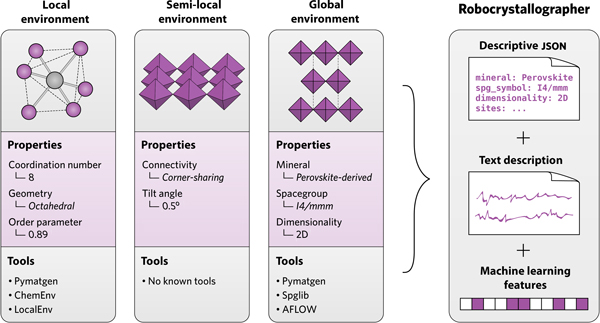Crossref Citations
This article has been cited by the following publications. This list is generated based on data provided by
Crossref.
Zimmermann, Nils E. R.
and
Jain, Anubhav
2020.
Local structure order parameters and site fingerprints for quantification of coordination environment and crystal structure similarity.
RSC Advances,
Vol. 10,
Issue. 10,
p.
6063.
Poletaev, D.O.
Aksyonov, D.A.
and
Lipnitskii, A.G.
2020.
Evolutionary search for new compounds in the Ti–Si system.
Calphad,
Vol. 71,
Issue. ,
p.
102201.
Shen, Jimmy-Xuan
Horton, Matthew
and
Persson, Kristin A.
2020.
A charge-density-based general cation insertion algorithm for generating new Li-ion cathode materials.
npj Computational Materials,
Vol. 6,
Issue. 1,
Banjade, Huta R.
Hauri, Sandro
Zhang, Shanshan
Ricci, Francesco
Gong, Weiyi
Hautier, Geoffroy
Vucetic, Slobodan
and
Yan, Qimin
2021.
Structure motif–centric learning framework for inorganic crystalline systems.
Science Advances,
Vol. 7,
Issue. 17,
Pan, Hillary
Ganose, Alex M.
Horton, Matthew
Aykol, Muratahan
Persson, Kristin A.
Zimmermann, Nils E. R.
and
Jain, Anubhav
2021.
Benchmarking Coordination Number Prediction Algorithms on Inorganic Crystal Structures.
Inorganic Chemistry,
Vol. 60,
Issue. 3,
p.
1590.
Gupta, Kapil
Bhattacharjee, Satadeep
and
Lee, Seung-Cheol
2021.
CINEMAS: Comprehensively INtegrated Environment for advanced MAterials Simulations.
Computational Materials Science,
Vol. 188,
Issue. ,
p.
110238.
Gavryushkin, Pavel N.
Sagatova, Dinara N.
Sagatov, Nursultan
and
Litasov, Konstantin D.
2021.
Formation of Mg-Orthocarbonate through the Reaction MgCO3 + MgO = Mg2CO4 at Earth’s Lower Mantle P–T Conditions.
Crystal Growth & Design,
Vol. 21,
Issue. 5,
p.
2986.
George, Janine
2021.
Automation in DFT-based computational materials science.
Trends in Chemistry,
Vol. 3,
Issue. 9,
p.
697.
Stach, Eric
DeCost, Brian
Kusne, A. Gilad
Hattrick-Simpers, Jason
Brown, Keith A.
Reyes, Kristofer G.
Schrier, Joshua
Billinge, Simon
Buonassisi, Tonio
Foster, Ian
Gomes, Carla P.
Gregoire, John M.
Mehta, Apurva
Montoya, Joseph
Olivetti, Elsa
Park, Chiwoo
Rotenberg, Eli
Saikin, Semion K.
Smullin, Sylvia
Stanev, Valentin
and
Maruyama, Benji
2021.
Autonomous experimentation systems for materials development: A community perspective.
Matter,
Vol. 4,
Issue. 9,
p.
2702.
Sawada, Motonari
Iwamoto, Ryoga
Kotani, Takao
and
Sakakibara, Hirofumi
2022.
Bond-length distributions in ionically bonded materials with decomposition by coordination environment.
Journal of Applied Crystallography,
Vol. 55,
Issue. 5,
p.
1359.
Sagatova, Dinara N.
Gavryushkin, Pavel N.
Sagatov, Nursultan E.
and
Banaev, Maksim V.
2022.
High-pressure transformations of CaC2O5– a full structural trend from double [CO3] triangles through the isolated group of [CO4] tetrahedra to framework and layered structures.
Physical Chemistry Chemical Physics,
Vol. 24,
Issue. 38,
p.
23578.
Shevchenko, Alexander P.
Smolkov, Michail I.
Wang, Junjie
and
Blatov, Vladislav A.
2022.
Mining Knowledge from Crystal Structures: Oxidation States of Oxygen-Coordinated Metal Atoms in Ionic and Coordination Compounds.
Journal of Chemical Information and Modeling,
Vol. 62,
Issue. 10,
p.
2332.
Ciftci, Yasemin O.
and
Alp, Irem O.
2022.
A first-principles prediction on the structural, electronic, elastic, phonon, and transport properties of BaSiN2.
Indian Journal of Physics,
Vol. 96,
Issue. 14,
p.
4131.
Arnold, Michael
Katzmann, Julia
Naik, Aakash
Görne, Arno L.
Härtling, Thomas
George, Janine
and
Schuster, Christiane
2022.
Investigations on electron beam irradiated rare-earth doped SrF2 for application as low fading dosimeter material: evidence for and DFT simulation of a radiation-induced phase.
Journal of Materials Chemistry C,
Vol. 10,
Issue. 32,
p.
11579.
Patel, H.S.
Dabhi, V.A.
and
Vora, A.M.
2022.
First principles investigation of thermoelectric properties of TiBeO3.
Materials Today: Proceedings,
Vol. 67,
Issue. ,
p.
151.
Preeda, P.
Ganapathi Raman, R.
and
Sakthivel, P.
2022.
Structural, FTIR, FT-Raman, optical and nonlinear optical properties of organic nonlinear optical crystal –3,5-diisopropyl-2-hydroxybenzoic acid.
Inorganic Chemistry Communications,
Vol. 146,
Issue. ,
p.
110120.
Massuyeau, Florian
Broux, Thibault
Coulet, Florent
Demessence, Aude
Mesbah, Adel
and
Gautier, Romain
2022.
Perovskite or Not Perovskite? A Deep‐Learning Approach to Automatically Identify New Hybrid Perovskites from X‐ray Diffraction Patterns.
Advanced Materials,
Vol. 34,
Issue. 41,
Bagheri, Mohammad
Berger, Ethan
and
Komsa, Hannu-Pekka
2023.
Identification of Material Dimensionality Based on Force Constant Analysis.
The Journal of Physical Chemistry Letters,
Vol. 14,
Issue. 35,
p.
7840.
Shinohara, Kohei
Togo, Atsushi
and
Tanaka, Isao
2023.
Algorithms for magnetic symmetry operation search and identification of magnetic space group from magnetic crystal structure.
Acta Crystallographica Section A Foundations and Advances,
Vol. 79,
Issue. 5,
p.
390.
Patel, H S
Dabhi, V A
and
Vora, A M
2023.
First principles investigation of electronic and elastic properties of strontium oxide and strontium peroxide phases: insights into structural stability and phase transitions.
Physica Scripta,
Vol. 98,
Issue. 12,
p.
125930.
